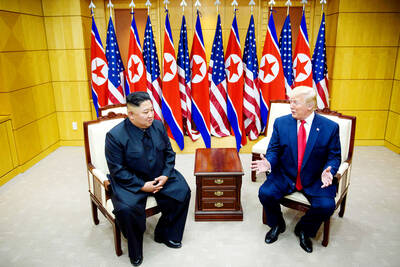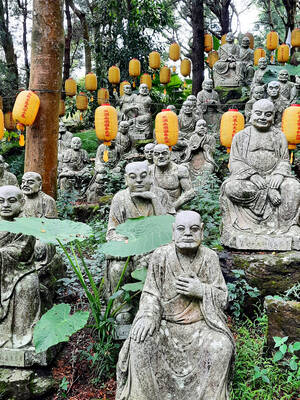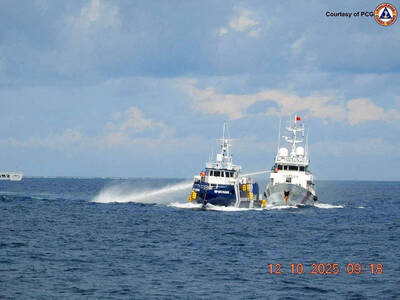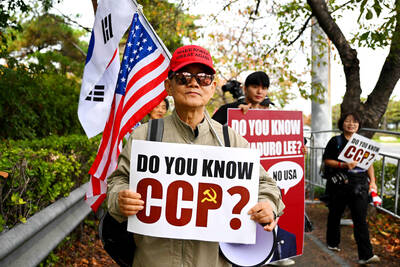With an US$80 million budget, which makes Red Cliff (赤壁) the most lavish Asian production to date, and a running time of more than four hours, which has seen the movie split into two installments, John Woo's (吳宇森) Chinese sword-and-sandals epic marks a triumphant return home for the director after 16 years in Hollywood.
Set in the Three Kingdoms period of China's history and centering on the legendary Battle of Red Cliffs (赤壁之戰), the epic sees Woo live up to his reputation as a masterful storyteller who reinvigorates a somewhat overworked and cliched genre with a good old-fashioned narrative developed by a rich cast of capable actors.
Set during the Han Dynasty's death throes, the film opens with shrewd Prime Minister Cao Cao (Zhang Fengyi, 張豐毅) sending his million-strong army and a sizable fleet off on an unprecedently large campaign to forge a unified empire. Unable to match Cao's army, the benevolent exiled leader Liu Bei (You Yong, 尤勇) sends his military strategist Zhuge Liang (Takeshi Kaneshiro, 金城武) to secure an alliance with Sun Quan (Chang Chen, 張震), a southern warlord.
Buttressed by formidable warriors such as Zhao Yun, Guan Yu, Zhang Fei, Zhuge Liang and Zhou Yu (Tony Leung Chiu-wai, 梁朝偉), Zhuge Liang successfully contrives to defeat Cao's vastly superior land force.
The victory proves to be Pyrrhic when the allied forces find themselves confronted by Cao's fleet of more than 2,000 warships anchored off shore. As the decisive battle looms, the two military masterminds scheme to secure victory.
Having opened in China, Hong Kong, South Korea and Taiwan yesterday, this is the diptych's first segment. The second part is scheduled for release in Asia in January of next year. The epic's lengthy running time is justified by Woo's grand narrative, which is told in the vein of Star Wars and Lord of the Rings. With the filmmaking luxury of length, Woo defines his characters through anecdotes and slowly builds up the tensions and the contrasts between the two opposing sides, which culminate in a Good vs Evil finale.
Though there are lavish sets, spectacular choreography and massive battle scenes enhanced by CGI effects, it is the substantive narrative that sets Red Cliff apart from the glut of big-budget Chinese historical dramas that have been released in recent years.
Audiences quickly find themselves falling for the colorful ensemble of characters and become absorbed in the film's narrative threads, which are enlivened by imaginative camera work, fast-paced editing and superbly executed choreography. Even ancient China's military wisdom is made sexy and enthralling when Takeshi Kaneshiro and Tony Leung Chiu-wai take on the roles of master tacticians in a complex battle that involves a maze-like military formation.
Woo's unconventional interpretations of historical figures have caused controversy. Doubts serviced when the director cast Japanese-Taiwanese actor Takeshi Kaneshiro as one of China's most revered scholars. If audiences expect the heartthrob to exude Chinese virtue and be the living embodiment of intellectuality, they'll be sorely disappointed. Instead, the actor gives the crusty character Zhuge Liang a playful update, bringing a sometimes slightly sissy young scholarly strategist to the big screen.
The casting of Taiwanese supermodel Lin Chi-ling (林志玲) also raised a few eyebrows, but she manages to hold her own in the film.
With Red Cliff, Woo proves that China's rapidly developing film industry has both the know-how and talent to make Hollywood-style blockbusters. The country also has a seemingly inexhaustible archive of historical narratives to plunder at will, so expect many more to follow. Hopefully, more will be as well-made as this one.

US President Donald Trump may have hoped for an impromptu talk with his old friend Kim Jong-un during a recent trip to Asia, but analysts say the increasingly emboldened North Korean despot had few good reasons to join the photo-op. Trump sent repeated overtures to Kim during his barnstorming tour of Asia, saying he was “100 percent” open to a meeting and even bucking decades of US policy by conceding that North Korea was “sort of a nuclear power.” But Pyongyang kept mum on the invitation, instead firing off missiles and sending its foreign minister to Russia and Belarus, with whom it

When Taiwan was battered by storms this summer, the only crumb of comfort I could take was knowing that some advice I’d drafted several weeks earlier had been correct. Regarding the Southern Cross-Island Highway (南橫公路), a spectacular high-elevation route connecting Taiwan’s southwest with the country’s southeast, I’d written: “The precarious existence of this road cannot be overstated; those hoping to drive or ride all the way across should have a backup plan.” As this article was going to press, the middle section of the highway, between Meishankou (梅山口) in Kaohsiung and Siangyang (向陽) in Taitung County, was still closed to outsiders

Many people noticed the flood of pro-China propaganda across a number of venues in recent weeks that looks like a coordinated assault on US Taiwan policy. It does look like an effort intended to influence the US before the meeting between US President Donald Trump and Chinese dictator Xi Jinping (習近平) over the weekend. Jennifer Kavanagh’s piece in the New York Times in September appears to be the opening strike of the current campaign. She followed up last week in the Lowy Interpreter, blaming the US for causing the PRC to escalate in the Philippines and Taiwan, saying that as

The Chinese Communist Party (CCP) has a dystopian, radical and dangerous conception of itself. Few are aware of this very fundamental difference between how they view power and how the rest of the world does. Even those of us who have lived in China sometimes fall back into the trap of viewing it through the lens of the power relationships common throughout the rest of the world, instead of understanding the CCP as it conceives of itself. Broadly speaking, the concepts of the people, race, culture, civilization, nation, government and religion are separate, though often overlapping and intertwined. A government